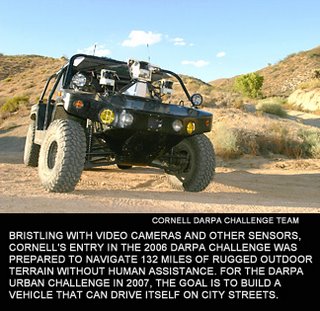U-M to lead another NASA comet mission
 NASA announced today that it has accepted the University of Maryland proposal to send the Deep Impact spacecraft on an extended mission to get a close-up look at Comet Boethin.
NASA announced today that it has accepted the University of Maryland proposal to send the Deep Impact spacecraft on an extended mission to get a close-up look at Comet Boethin.The University of Maryland-led team that produced the spectacular Deep Impact mission, which smashed an impactor into Comet Tempel 1 in July, 2005, hopes new information gathered from Comet Boethin will help coalesce the vast array of new cometary information into solid ideas about the nature of comets, how they formed and evolved and if they have played a role in the emergence of life on Earth.
“As we try to interpret the larger meaning for all comets of our results from Deep Impact at Tempel 1, we have realized more and more how important is the variation from comet to comet,” said Deep Impact leader and University of Maryland astronomer Michael A'Hearn.
“Deep Impact's flyby spacecraft and payload are still healthy. We propose to direct the spacecraft for a flyby of Comet Boethin in December, 2008, to investigate whether the results found at Comet Tempel 1 are unique or are also found on other comets,” said A’Hearn.
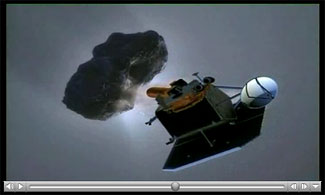 "This mission is a very cost effective way to provide new results that can be directly compared to the landmark Deep Impact findings as well as with the results of Deep Space 1 and Stardust and the earlier results from the numerous missions to Comet Halley.”
"This mission is a very cost effective way to provide new results that can be directly compared to the landmark Deep Impact findings as well as with the results of Deep Space 1 and Stardust and the earlier results from the numerous missions to Comet Halley.”Mission DIXI::
The proposed new mission is called DIXI., which stands for Deep Impact eXtended Investigation. DIXI will use the surviving Deep Impact spacecraft and its three working instruments (two color cameras and an IR spectrometer).
Comet Boethin is now inbound to the sun from its most distant point that is nearly out to the orbit of Saturn, A’Hearn says. “At encounter, Comet Boethin will be just outside Earth’s orbit, closer to the sun than was Tempel 1 (at the orbit of Mars) but about the same distance from Earth.”
Like Deep Impact, DIXI will be a partnership between the University of Maryland, NASA's Jet Propulsion Laboratory (JPL), and Ball Aerospace & Technologies Corporation.
"One of the great surprises of comet explorations has been the wide diversity among the different cometary surfaces imaged to date," said A'Hearn, who will be principal investigator for DIXI. “Even on Tempel 1, the comet we've imaged the best, there is shocking variability in its surface. The comet's different surface types clearly have undergone different histories.
A'Hearn says the data obtained from DIXI will also will help scientists determine which characteristics of comet structure and composition are primordial, reflecting conditions and processes that existed 4.5 billion years ago when the solar system formed, and which are the result of evolutionary forces (heating and cooling, impacts, etc.) that have acted on comets since that time.
"Data from comets can help us to better understand the origin of the solar system, as well as what role, if any, comets may have played in the emergence of life on Earth," said Jessica Sunshine, a member of the Deep Impact science team, who will be deputy principal investigator on DIXI. "However, we first must know which cometary characteristics are due to evolution and which are primordial."
Deep Impact Surprises::
Deep Impact was the first large scale experiment ever conducted on a comet. The Deep Impact flyby spacecraft made many surprising discoveries on approach to Comet Tempel 1. These include an extremely fluffy composition that largely insulates the interior from heat experienced by the surface; frequent, natural outbursts; major differences in the distribution of carbon dioxide and water; craters and other surprising geological features; demonstration that the ice below the surface must be evaporating (subliming) to water vapor, and the first detection of ice (a very small amount) on a cometary nucleus.
"Since half the discoveries at Tempel 1 were from the flyby data taken before impact, DIXI can return half the science of Deep Impact for much less than 10 percent of the cost of Deep Impact," A’Hearn said. “From the point of view of cost effective science, an extended mission such as DIXI is unbeatable."
Greener News Room
Keywords:: DEEP IMPACT COMETS NASA COMET BOETHIN ASTRONOMY SPACE SPACECRAFT



3:07 PM





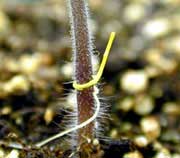 De Moraes has been working with the weed, which attaches to its host plant "like a leech that will attach to the plant and then suck the nutrients out. But as a parasitic plant, you don't want to kill your host plant ... what you want to do is maintain that plant alive," she says. If that sounds more like a "vampire weed," consider that it's also practically immortal.
De Moraes has been working with the weed, which attaches to its host plant "like a leech that will attach to the plant and then suck the nutrients out. But as a parasitic plant, you don't want to kill your host plant ... what you want to do is maintain that plant alive," she says. If that sounds more like a "vampire weed," consider that it's also practically immortal.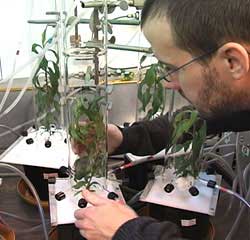 Working with
Working with 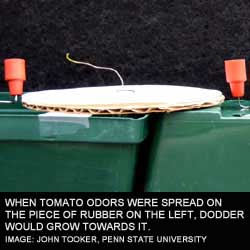 When the researchers isolated tomato plant volatiles and smeared them on the piece of rubber, dodder tried to attack that. Seventy-three percent of the seedlings headed toward the piece of rubber with tomato chemicals compared to a plain piece of rubber. While the dodder weed doesn't have a nose, De Moraes theorizes that the weed has special receptors that can detect those chemicals. "They don't have any leaves," she says, "we believe that they have receptors that perceive the smell of those airborne chemicals and then they are growing towards the host plant."
When the researchers isolated tomato plant volatiles and smeared them on the piece of rubber, dodder tried to attack that. Seventy-three percent of the seedlings headed toward the piece of rubber with tomato chemicals compared to a plain piece of rubber. While the dodder weed doesn't have a nose, De Moraes theorizes that the weed has special receptors that can detect those chemicals. "They don't have any leaves," she says, "we believe that they have receptors that perceive the smell of those airborne chemicals and then they are growing towards the host plant."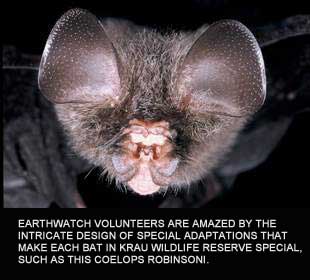 “This 30-million-year-old rainforest is a bat paradise,” said Dr. Tigga Kingston, assistant professor of biology at Texas Tech University and principal investigator of Earthwatch’s Malaysian Bat Conservation project. “It is home to the greatest diversity of insect-eating bats in the world, with at least 60 species. When the fruit-eating bats are included, the species list tops 71 bats.”
“This 30-million-year-old rainforest is a bat paradise,” said Dr. Tigga Kingston, assistant professor of biology at Texas Tech University and principal investigator of Earthwatch’s Malaysian Bat Conservation project. “It is home to the greatest diversity of insect-eating bats in the world, with at least 60 species. When the fruit-eating bats are included, the species list tops 71 bats.”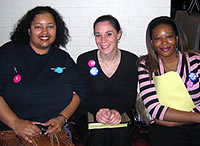



 Solar sailing is about to hit big time. The concept of harnessing the ocean’s abundant wind and sun to power any modern boat began ten years ago. The first solar sailing ferry with moveable solar wings has been operating in Sydney for six years now, and its designer has just won a contract to build another in San Francisco.
Solar sailing is about to hit big time. The concept of harnessing the ocean’s abundant wind and sun to power any modern boat began ten years ago. The first solar sailing ferry with moveable solar wings has been operating in Sydney for six years now, and its designer has just won a contract to build another in San Francisco.